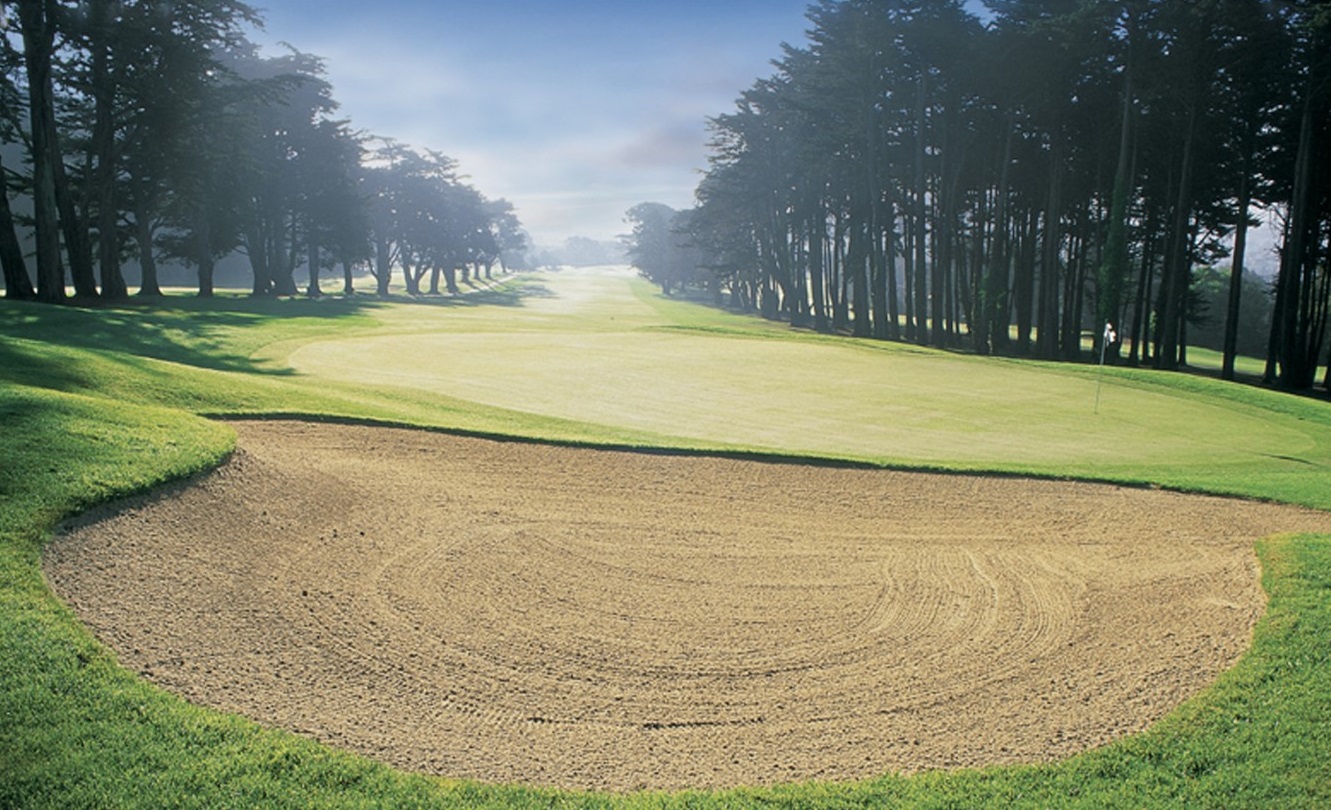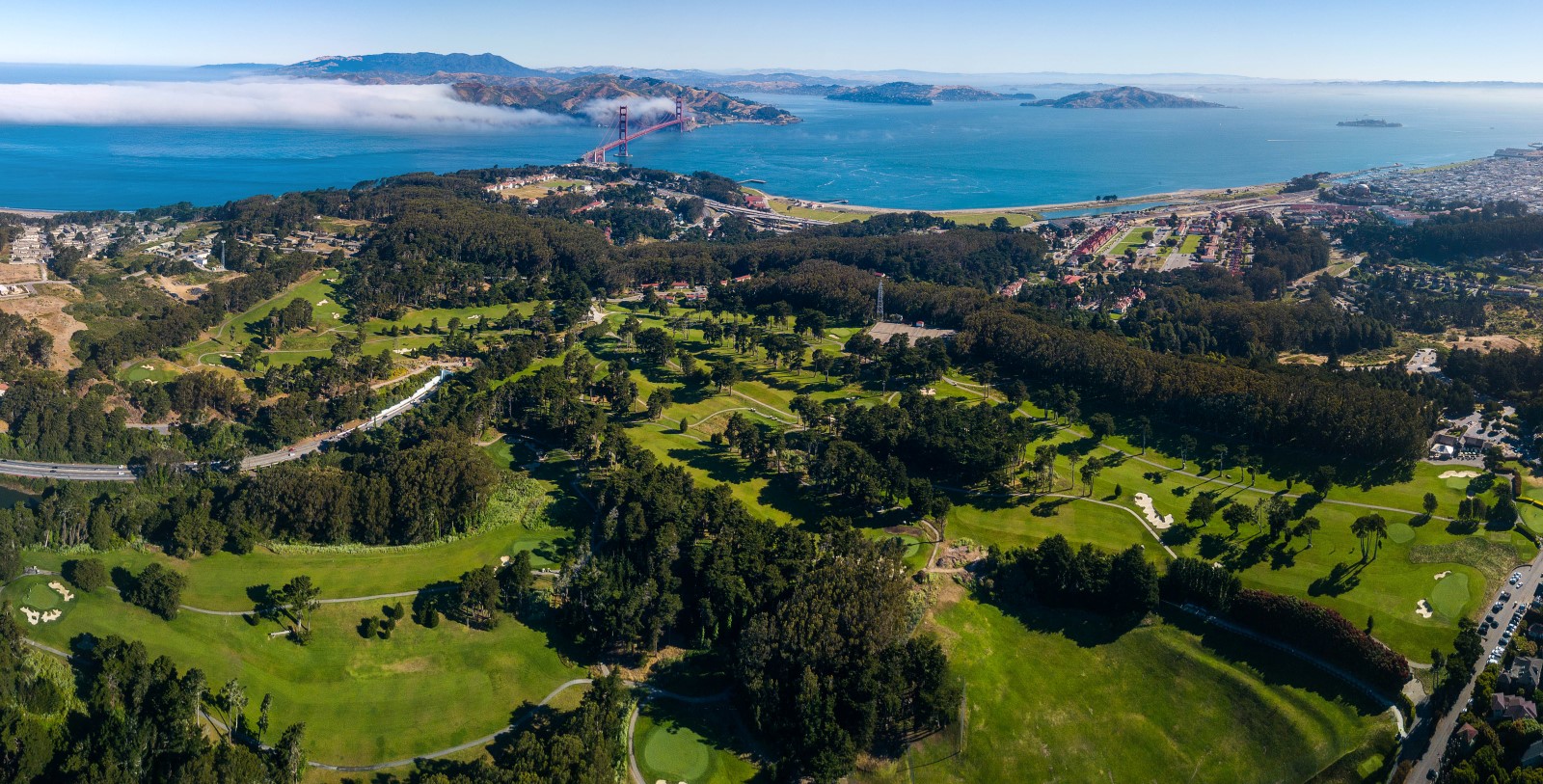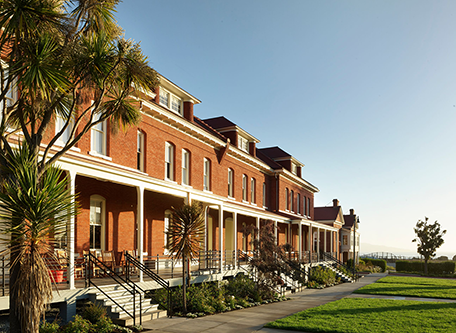Receive for Free - Discover & Explore eNewsletter monthly with advance notice of special offers, packages, and insider savings from 10% - 30% off Best Available Rates at selected hotels.
presidio golf course
Discover the Presidio Golf Course, which has hosted the likes of Babe Ruth, Joe DiMaggio, Bob Hope, Bing Crosby, and Charles M. Schulz.

Presidio Golf Course
Get introduced to the fantastic layout of the historic Gilded-Age Presidio Golf Course.
WATCH NOWLocated within the Presidio of San Francisco, California, the Presidio Golf Course is among the most historic golf courses still active in the western United States. Its origins specifically harken back to a group of San Francisco-based businesspeople who petitioned the Presidio’s commander, Colonel William M. Graham, to develop a golf course on the grounds of the base. The new facility would serve as the home for the entrepreneurs’ private golf organization, the San Francisco Golf and Country Club. The Colonel accepted their request on the condition that the course be open to both the civilian members of the club and the military. As such, the San Francisco Golf and Country Club commissioned landscape architect John Lawson to create their prospective course in 1895. Lawson himself took great pride in the endeavor, telling contemporaries: “God shaped this land to be a golf course. I simply followed nature.” Taking months to complete, he ultimately crafted a beautiful, nine-hole course. Indeed, army officers and club members alike thoroughly enjoyed playing on the course to the point where it was booked every week. In fact, the surging popularity caused the San Francisco Golf and Country Club to petition for its expansion a few years later. Unfortunately, the U.S. Army delayed in approving the plans, forcing most of the club’s members to leave for a new course by Lake Merced. The remaining civilian golfers thus formed a new entity called the Presidio Golf Club, which finally succeeded in getting the Presidio Golf Course renovated in 1910. Architect Robert Wood Johnstone collaborated with William McEwan to spearhead the new design, who installed another nine holes throughout the complex.
While the relationship between the U.S. Army and the Presidio Golf Club initially remained good-natured, it did eventually become tense. The greatest moment of animosity arose in 1912, when one officer ordered a couple of club members to vacate the premises in favor of his own group. The fighting had grown so bad that the Presidio’s command post forbade civilian golfers from wandering the course at any time! Only the intervention of the Secretary of the Interior and Congress on behalf of the Presidio Golf Course ended the whole dispute. In the wake of the controversy, the Presidio Golf Club assumed complete control over the course’s maintenance and management. In 1921, the club initiated its largest rehabilitation project to date when it hired British firm Fowler & Simpson to increase the size of the course exponentially. The company also installed a modern irrigation system to help the Presidio Golf Club standardize its greenkeeping practices at a professional level. The club’s continued stewardship proved masterful, as the course gradually developed a celebrated national reputation. Many golfers from across the country were invited to play a round or two over the following years, including famous individuals like Babe Ruth, Joe DiMaggio, Bob Hope, Bing Crosby, and Charles M. Schulz. (DiMaggio himself was known to schedule his tee times at the crack of dawn to avoid the paparazzi.) But in 1956, the U.S. Army assumed responsibility over the location, in order to finance another massive round of renovations. Nevertheless, the Presidio Golf Club and the U.S. Army continued to share the facility for many years thereafter, with both organizations working hard to preserve its legacy.
In 1994, the Presidio ceased functioning as a military base following Congress’ decision to shutter its operations five years earlier. The federal government proceeded to transform the coastal area of the Presidio into a renowned national park. Meanwhile, Congress authorized the Presidio Trust to manage the remaining portion of the site, including its fantastic, 18-hole golf course. The Presidio Golf Course subsequently reopened as a brilliant public course to great acclaim in 1995. (The Presidio Golf Club continued to operate as a members-only entity, which constructed a brand-new clubhouse in 1999.) The Presidio Trust continues to manage the Presidio Golf Course today, which still remains one of California’s most celebrated golfing destinations. With its amazing collection of Eucalyptus and Monterrey Pine trees, the Presidio Golf Course’s 6,500-yard layout has earned it great praise in the wake of its most recent debut. In fact, the Presidio Golf Course has become notable for its environmentally sensitive management practices. As such, the course has even been recognized as a leader in environmentally sensitive golf course management, winning the “Environmental Leader in Golf Award” during the early 2000s. Since then, the course has reduced overall pesticide use by approximately 50 percent, and currently uses approximately 75 percent less pesticide than other private courses in San Francisco. The course also received certification from Audubon International as a partner in the Audubon Cooperative Sanctuary Program in 2003.
-
About the Location +
A part of the much larger Golden Gate Recreational Area, the Presidio was once a sprawling military base located toward the western end of the San Francisco Peninsula. The region covers a landmass of some 2.3 square miles and has been recognized as a national park since 1996. The Presidio of San Francisco has received several historical designations throughout its history, too, becoming a California Historical Landmark in 1993 and a National Historical Landmark in 1962. It connects directly to the historic Golden Gate Bridge, which specifically passes by its northernmost installation—Fort Point National Historic Site. Most of the surviving historic structures reside within a section of the Presidio known as the “Main Post.” The Main Parade Ground resides just to the east of the Main Post, while Fort Winfield Scott resides to the west. Other locations that define the eastern side of the Presidio include the former grounds of Letterman Army Hospital and the San Francisco National Cemetery. The historic structures affiliated with the once active Crissy Field lie next to Fort Winfield Scott. A ring of enclosed concreate field guns line the Presidio’s coastline, including Battery Chamberlin, Battery East, and Battery Marcus Miller. Yet, the Presidio of San Francisco doubles today as a massive nature preserve, filled with dozens of hiking trails and scenic overlooks. Perhaps its most famous outdoor attraction is the majestic Marshall’s Beach. Thousands of recently planted trees also call the Presidio home, with such species as eucalyptus, pine, and cypress filling the southern end of the park in large numbers. But other privately owned cultural attractions have populated the Presidio of San Francisco in recent years, like The Walt Disney Family Museum.
The history of the Presidio is immense, far too great to cover in detail here. Nonetheless, it was formally founded in 1776, when Lieutenant Colonel Juan Bautista de Anza ordered a cross erected on the Punta del Cantil Blanco just above the mouth of San Francisco Bay. By raising the cross, de Anza had followed conventional Spanish protocols to set aside land for official military development. He had hoped that the heights would be sufficient to guard against any encroachments by rival European powers that wanted to inhabit the region. Juan Bautista de Anza soon dispatched his second-in-command, Jose Moraga, to lead an expedition from present-day Arizona to the site for its settlement. The installation that Moraga’s men created was nothing more than a small adobe surrounded by a few quaint agricultural structures that they called the “El Presidio Real de San Francisco.” Constructed alongside the Mission San Francisco de Asis, the military installation functioned more as an outpost for the distant Viceroyalty of New Spain (now modern-day Mexico). Life was often difficult for the soldiers of the garrison, as they received little government support. As a result, they engaged in activities like farming and hunting just as much as their normal military duties. Their situation became a bit better in the 1790s though, when the garrison developed an imposing coastal battery named the “Castillo de San Joaquin.” Manned by half-a-dozen cannons, it greatly enhanced the soldiers’ ability to deter the British and the Russians from invading the bay.
For the next two decades, the citadel protected the entrance into San Francisco Bay on behalf of the Spanish Empire, until Mexico achieved its independence in 1821. Despite news of the event taking a full year to reach the outpost, the soldiers declared its loyalty to the new Mexican government. But the Presidio became even more remote, and its garrison gradually left for bases further to the south. The largest exodus occurred under Mariano Vallejo, who led all but a squad of soldiers to nearby Sonoma in 1835. The decision to relocate the garrison several hundred miles away proved costly, as American forces easily captured the structure at the onset of the Mexican-American War. Originally inhabited by a unit of cavalry, a few companies of the 1st New York Volunteer Regiment moved into the Presidio in 1847. From the base, they served as an occupational unit that coordinated the defense of the entire bay region, thus beginning the Presidio’s role in protecting the western United States. This responsibility was further augmented when thousands of Americans flooded the region at the start of the California Gold Rush in 1849. The U.S. Army—which had formally assumed control over the base around the same time—began an arduous reconstruction project that saw the Presidio slowly transform into a sprawling military installation. The old Castillo de San Joaquin was replaced with Fort Point, while the heavily forested region immediately to the south was cleared to make way for new administrative buildings. The Presidio quickly became the nerve center for the defenses ringing San Francisco, directing orders to such faraway places like the Marin Headlands and Fort Funston.
After the American Civil War, the Presidio of San Francisco underwent a series of several massive expansions that saw its size increase tenfold. The War Department approved plans to erect a new series of coastal batteries with Fort Point at its center. It also commissioned the creation of the many buildings that constituted the Presidio’s Main Post, including around a dozen barracks built along its iconic Main Parade Ground. Further developments occurred around the start of the 20th century, including the creation of the Letterman Army Hospital (1898) and Fort Winfield Scott (1912). Among the last greatest additions to the Presidio was Crissy Field in 1921, which was a pioneering military aviation center operated by the legendary Henry “Hap” Arnold. At this point, the Presidio had become one of the five largest military bases in the entire country. Letterman Army Hospital alone was the U.S. Army’s biggest facility, capable of several thousand patients at once. It also served as the most important Army base along the West Coast, functioning as the primary training, supply, and embarkation post for soldiers destined to serve overseas in the Pacific. Indeed, the Army relied on the Presidio to funnel units to Asia in World War II, the Korean War, and the Vietnam War. It even briefly served as the headquarters for both the Fourth and Sixth U.S. Armies, which presided over the entire national defense apparatus of the western United States at various points in time.
When the Cold War finally ended during the 1980s, Congress started drafting plans to demobilize much of America’s standing military. Those plans included the deactivation of the country’s military bases except for the most critical. Congress outlined the particular aspects of its strategy within its Base Realignment and Closure program, which ultimately decommissioned some 350 military installations throughout the United States. The Presidio of San Francisco was among the first to be shuttered, considered to be non-essential in 1989. Congress formally voted to close the facility five years later, concluding the Presidio’s three-century-long career as a military base. It then turned over to the Presidio to the National Park Service to operate as one of its parks. But in 1996, Congress decided to create the Presidio Trust to help oversee much of the Presidio’s management. As such, the Presidio Trust was left in charge of most of the site, while the National Park Service retained direct control over the shoreline. Congress also mandated that the Presidio Trust become fully self-sufficient, which it achieved completely in 2005. Now one of San Francisco’s most iconic destinations, the Presidio of San Francisco has a history that few other places in the United States can claim to possess.
-
About the Architect +
Tom Simpson and Herbert Fowler: While many golf course architects have worked on the Presidio Golf Course over the years, the firm of Tom Simpson and Herbert Fowler arguably left the greatest impact. One part of the duo, Herbert Fowler, was an accomplished athlete who had first made a name for himself playing cricket during his youth. But Fowler had also found prominence as one of the partners managing “Fox Bros. Fowler & Co. Bank.” Fowler himself first discovered the game of golf at the Royal North Devon while out on business in 1879. Taking to it quickly, he practiced the game obsessively at a facility known as “Westward Ho!” and began competing in amateur competitions. Indeed, Fowler was soon making top finishes at several tournaments, including the British Open and the Amateur Championship. He was even selected to help represent England during the 2nd England-Scotland Amateur Match, playing alongside the likes of Bernard Darwin, John Ball, and Harold Hilton. Unfortunately, Fowler’s finances had completely fallen apart, resulting in his bankruptcy right before the onset of his playing career. Much of his debt belonged to his brother-in-law, Sir Henry Cosmo Bonsor. To help Fowler find a way out of his indebtedness, Bonsor requested that he develop a golf course upon some land at a place called “Walton Heath.” Despite having zero experience in landscape architecture, Fowler nonetheless constructed the facility in 1902. Taking many months to complete, Fowler managed to construct a fantastic 6,424-yard course that quickly established a reputation as one of England’s best. The debut of Walton Heath Golf Club further solidified Fowler’s growing repute within the world of golf, as he had just secured a vaunted membership in The Royal & Ancient Golf Club of St Andrews. As such, many other golf clubs approached Fowler with the request that he work on their prospective courses.
Then in 1910, Fowler decided to form a partnership with another landscape architect named Tom Simpson. Much younger than Fowler, Simpson had practiced law for five years before taking the opportunity to work with the golfer. His passion for golf course architect had specifically arisen after observing the renovations done to Woking Golf Club when he was just a member. Inspired, Simpson sought out a career with Fowler and the two began designing numerous golf courses throughout Europe. Once World War I had passed, the men had formed an equal partnership alongside two other architects named J.F. Abercromby and Arthur Croome. Simpson himself took the lead in designing and redesigning many of the company’s projects throughout continental Europe, primarily in France and Belgium. Among the best courses he worked on at the time included Golf de Chantilly and Golf de Mortefontaine. Meanwhile, Fowler specialized in crafting courses back home in the United Kingdom, such as Aberdovey Golf Club, Cruden Bay Golf Club, and Royal Lytham & St Annes Golf Club. Even though Fowler and Simpson’s firm had a focus on European golf courses, it did entertain a satellite branch in the United States, too. The office wound up renovating high-profile courses like Eastward Ho!, Pebble Beach Golf Links, and the Presidio Golf Course. By the end of the 1920s, the partnership between Fowler and Simpson had dissolved, with both men going their separate ways. Nevertheless, the two would remain deeply immersed in golf course design, working on several other club layouts for the remainder of their respective lives. Fowler himself kept building courses all over the British Isles until his death in 1941. Simpson remained active for much longer though, crafting a few courses across the Iberian Peninsula in the aftermath of World War II. He then formed a brief partnership with C.K. Cotton, before finally retiring for good during the 1950s.
-
Famous Historic Golfers +
Bing Crosby, singer and actor known for his roles in Going My Way and The Bells of St. Mary’s.
Bob Hope, comedian and patron of the United Service Organization (USO).
Babe Ruth, outfielder for the New York Yankees that is regarded as being the best baseball player in the sport’s history.
Joe DiMaggio, outfielder for the New York Yankees best remembered as the “Yankee Clipper.”
Charles M. Schulz, cartoonist best remembered for creating the celebrated comic strip, Peanuts.
































